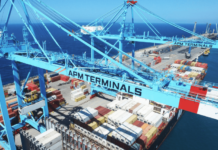
As the climate disruption in Panama and the spread of the Middle East conflict restricts the flow of trade on both the Pacific and Asia to Europe services rates are expected to sharply increase on both routes.
Panama Canal disruption is caused by low water levels due to the lack rainfall, caused by El Nino and climate change, restricting transits by a third to just 24 a day. Some vessels on the Pacific have shifted operations via the Suez Canal to reach the US east coast, only to find Houthi missiles also blocking this route.
Large scale deliveries of newbuildings has meant that carrying capacity is not at risk, but diverting 3.4 million TEUs around the African Cape, some 12% of global capacity, will delay vessels, wreck scheduling and cause congestion at ports.
Industry analyst Jon Monroe believes vessel operators will manage capacity to drive rate levels upwards. “Ocean carriers are expected to tighten capacity using blank sailings to create a backlog of containers that will take them through the April-May period while they negotiate better contract rates,” he said.
Pointing out that carriers that are returning freight bound for the eastern seaboard of the US to west coast ports, Monroe sees this as an opportunity for carriers to “consider the opportunity” presented by the landbridge transit.
Additionally, volumes were forecast to rise 6.6% in December, but instead import containers ballooned to 11% as sales also saw an increase prompting Monroe to forecast a surge in orders as diminishing inventories need replenishing.
In Europe, the effect of the Red Sea crisis is already having a major impact on rates. One European forwarder told Container News rates will likely rise from the current US$4-5,000/FEU level to US$12,000/FEU by February with space on the Asia to Europe vessels in January already constrained, and new bookings now being taken only for February departures.
CMA CGM has announced peak season surcharges (PSS) on a number of routes of US$500/TEU on its Asia to North Europe, applicable since 1 January and taking Mediterranean rates to US$3,650/20ft dry box and US$6,300/FEU or for reefer cargo, all applicable from 15 January.
The indications are that these rates will stick, as the impact of the Houthi actions is expected to last, while European retailers are warning that prices are set to rise again.
Analysts are therefore forecasting extended supply chains, longer delivery times, elevated rates and port congestion in what appears to be a re-run of Covid disruptions.
Dynamar analyst Darron Wadey commented, “If the Cape of Good Hope diversions start taking a structural rather than temporarily expedient form, then there could be the opportunity for some remodelling of the Asia, North Europe, Mediterranean and West Africa trades.”
However, Wadey also notes that the comparison with the pandemic crisis differs in two critical ways, firstly demand has fallen significantly and secondly there is an excess of capacity available to the lines as a consequence of vessel orders over the past three years.
“In some ways, the diversions around Africa will help avoid or mitigate an over-capacity situation, which was threatening to rear its head, especially if it also starts to move from being temporary to something approaching permanence,” he noted.
Wadey believes that any increase in rates should “only be a reflection of the increase in operating costs”.
“In practical terms, this relates to two or three extra ships on top of the current 12 or 13 needed to operate a standard Asia-Europe loop. The impacts of diverting will actually be felt more for Mediterranean dedicated loops and could see four extra ships needed on top of their usual ten/eleven,” he added.
This effect could be mitigated by turning ships around at the Straits of Gibraltar and feedering freight.
Mary Ann Evans
Correspondent at Large





